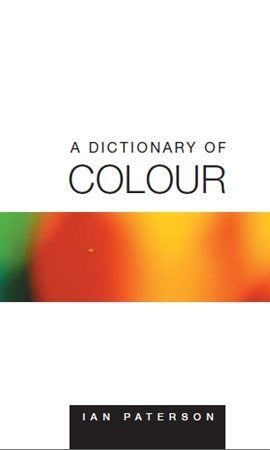A Dictionary of Colour

| Author: Ian Paterson | |
| Price: FREE | |
| We experience most other stimulae through two or more senses each corroborating the other. We can, for example, both hear and feel sound and we can see, feel and smell heat. | |
| Any attempt to define any particular colour merely by means of words is doomed to failure. We can illustrate the general nature of any particular colour by reference to an object having the same quality (which begs the question) or by reference to its wavelength (which is of interest only as a matter of physics) or by reference to another colour (which becomes circular). For example, Purple is defined in the new Oxford Dictionary as a colour intermediate between red and blue. Blue is defined as a colour intermediate between green and violet and violet is a bluish-purple colour. This work variously employs each of the above methods, but not with a view to providing definitions of colours. The vocabulary of colour is far too imprecise to make that objective a realistic one. The best way to indicate the meaning of a particular colour word is to display its actual colour. Many works have embarked on that task including, in particular, Maerz and Paul (A. Maerz and M. R. Paul, A Dictionary of Color 3rd Edition, New York, McGraw Hill, 1953). However, there is an infinite number of colours and shades, hues and tints (some suggest as many as 16 million) so that it would obviously not be possible to provide each of them with a distinct name. Furthermore, those colour descriptions which do exist do not have a sufficiently exact meaning to enable any colour to be determined with precision. No colour description in word form can convey the information necessary to enable the precise shade and tone to be identified. Indeed, some colour names included in this Dictionary have several different (and sometimes conflicting) meanings. This is only partly due to the fact that our language is in a constant state of flux. It is also as a result of the fact that the perception of colour is a highly subjective matter. Colour is nothing without sight and sight is the only sense by which we can experience colour. |
|
| Click for more eBooks from this publisher. |
. . . . . . . . . . . . . . . . . . . . . . . . . . . . . . . . . . . . . . . . . . . . . . . . . . . . . . . . . . . . . . . . . . . . . . . . . . . . . . . . . . . . . . . . . . . . . . . . . . . . . . . . . . . . . . . . . . . . . . . . . . . . . . . . . . . . . . . . . . . . . . . . . . . . . . . . . . . . . . . . . . . . . . . . . . . . . . . . . . . . . . . . . . . . . . . . . . . . . . . . . . . . . . . . . . . . . . . . . . . . . . . . . . . . . . . . . . . . . . . . . . . . . . . . . . . . . . . . . . . . . . . . . . . . . . . . . . . . . . . . . . . . . . . . . . . . . . . . . . . . . . . . . . . . . . . . . . . . . . . . . . . . . . . . . . . . . . . . . . . . . . . . . . . . .


